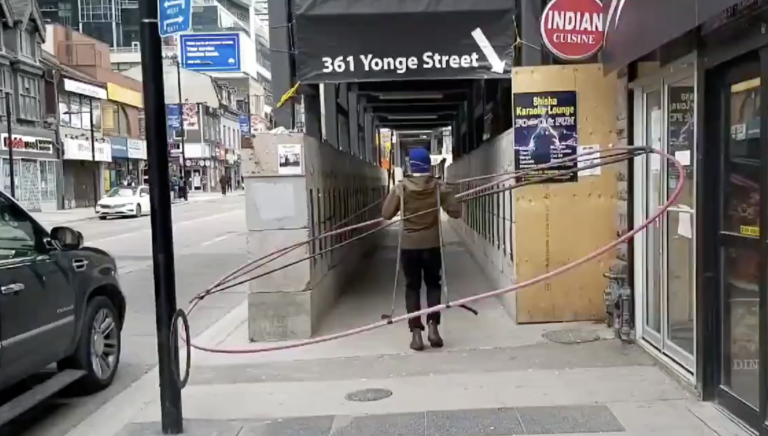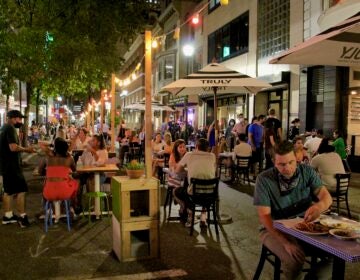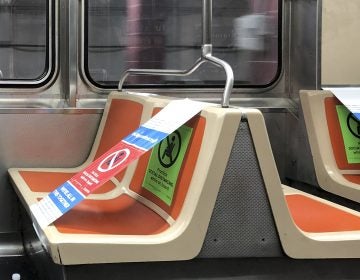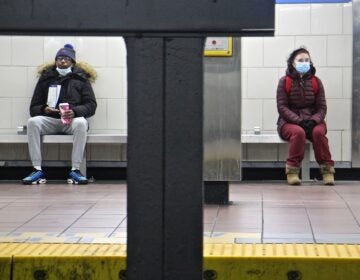Philly should close streets to cars, open space for social distancing, advocates say
Philadelphia pedestrian advocates pressure city to close more streets to cars so residents can practice safe social distancing outdoors during COVID-19 pandemic.

A Toronto geographer is using a large ring to study and demonstrate how difficult it is to keep a social distance of six feet in the urban environment. (Daniel Rotsztain)
A video from Toronto shows a man wearing his homemade Social Distancing Machine, a 13-foot-wide hoop that knocks against street furniture and annoys other pedestrians as he demonstrates how much space he needs to walk safely down the sidewalk. The soundtrack is M.C. Hammer’s “U Can’t Touch This.”
In a viral clip from Rome, a man stands in the Mercato Testaccio indoor market wearing a giant orange disc around his waist. Asked why he’s carrying the cardboard donut, he responds: “For coronavirus.”
Roma, mercato testaccio.#coronavirus #coronavirusitalia #11Marzo #iorestoacasa #restoacasa #chiuderetutto #COVID19 #roma #testaccio pic.twitter.com/wJBSf66Kyu
— L’Antikulturale (@Antikulturale) March 11, 2020
No social-distancing attire has been sighted in Philadelphia as of yet. But residents’ struggles to keep at least six feet away from each other during the COVID-19 pandemic has spawned spirited discussions about how to safely navigate the city’s narrow sidewalks and whether wider public spaces should be dedicated to walking and bicycling.
Dena Driscoll, a Passyunk Square resident and advocate on pedestrian issues, recently sat on her front steps and used an iPhone app to measure the distance to the curb.
“I live on a really teeny block, so it was just under four feet. I posted that on Twitter, and then other people were like, oh my gosh, and then they started measuring their sidewalks,” said Driscoll, co-chair of the 5th Square urbanist PAC. “There are certainly lots of people thinking about this right now.”
Walking around your neighborhood and visiting parks are among the very few recreational activities residents are still allowed to do outside their homes, boosting foot traffic in places and making it even more difficult to keep six feet apart.
On the extremely popular Schuylkill River Trail, “social distancing is problematic, if not impossible,” the leaders of the Center City Residents Association (CCRA) and the Logan Square Neighborhood Association (LSNA) wrote in a letter to Mayor Jim Kenney last Friday.
“Parks and sidewalks in every neighborhood are packed full of people needing to exercise and enjoy the physical and mental health benefits of being outside during this difficult time. Commercial corridors with narrow sidewalks are overcrowded as people access essential items like food,” six councilmembers wrote in another letter to the mayor.
Acknowledging the need for wider recreational spaces, the city last month banned cars from Martin Luther King Jr. Drive on the Schuylkill’s western bank, making it one of the first U.S. cities to convert a road to pedestrian use because of social-distancing needs. But the neighborhood associations, urbanist groups, and councilmembers say that first step is no longer enough, and many more streets around the city should be closed to cars, either partially or completely.
In their letter to Kenney, CCRA president Maggie Mund and LSNA president Dennis Boylan said the city should close the separated outer lanes of the Benjamin Franklin Parkway to cars. “With suitable encouragement, we think large numbers of walkers, runners, and bicyclists would be happy to take this alternate route to Kelly Drive and Martin Luther King Drive, thereby relieving congestion on the narrow Schuylkill trail,” they wrote.
The councilmembers went further, endorsing a proposal from the Bicycle Coalition of Greater Philadelphia, Clean Air Council and 5th Square to close 18 miles of streets around the city, including Kelly Drive, 9th Street in the Italian Market, and roads that go through FDR Park, Hunting Park, and West Fairmount Park, among others.
Councilmembers Darrell Clarke, Kenyatta Johnson, Jamie Gauthier, Helen Gym and Derek Green urged Kenney to act quickly on the request. They noted that other cities have recently surpassed Philadelphia in creating space for walking, with New York closing a number of streets around the city to cars. Boston, Minneapolis and Oakland, California have closed streets and other cities are repurposing parking lanes as pedestrian paths.
In Washington DC, complaints that the city government has not created enough space for walking led some residents to take matters into their own hands. On several streets they have blocked off parking lanes with traffic cones and caution tape or closed streets entirely, while urging officials to reduce the speed limit to 20 miles per hour.
City ‘reviewing’ open streets options
Philadelphia officials this week acknowledged the heavy use of the Schuylkill River Trail, MLK Jr. Drive and Kelly Drive, but said they have not decided on their next steps yet.
“We are reviewing whether we open additional streets to pedestrian access. Some of the challenges around that are certainly making sure we protect our resources, and specifically our police department resources,” Managing Director Brian Abernathy said. “We want to make sure whatever we do is equitable across the city to provide all of our residents with an opportunity to recreate outdoors.”
Asked about creating neighborhood Slow Zones, where streets are reconfigured to slow down traffic and make walking safer, Abernathy referenced the city’s financial crisis, which is expected to require deep and painful cuts to services in the coming months.
“We’ve got some financial problems and we’re going to have to work through those. Neighborhood slow zones cost money, and frankly we’re going to have to prioritize all our resources and our programs going forward. I’ve got to pay my police officers’ salaries before I install new slow zones,” he said. The city last year selected two neighborhoods for its first Slow Zones but construction is on hold during the pandemic.
Advocates look to ‘Play Streets’ as model
The groups behind the new street-closure proposal said they are mindful of cost and equity issues, and prioritized those concerns when they picked out streets they want to see closed to traffic.
“We fully acknowledge that resources are really tight, and we don’t think this needs to be something that draws on a lot of resources. The streets in FDR Park and Hunting Park have gates, just like MLK Drive does. It would cost zero resources on a day-to-day basis to keep those park roads closed down. It’s just a matter of closing a gate,” said Nick Zuwiala-Rogers, transportation project director at the Clean Air Council.
He pointed out that the city regularly closes streets for special events, such as the annual Italian Market Festival in May.
“It takes a sign and maybe a barrier to keep a road closed down. We don’t think there needs to be a police presence and a draw on resources,” he said. “Every summer we have block parties that take nothing more than a neighbor putting up a sign saying the block is closed down. So this is something that can be done for low cost, for sure.”
Driscoll noted that residents use simple barriers to close hundreds of residential blocks every summer as part of the Park and Recreation Department’s Play Streets program, which gives children a safe place to play and provides them with free lunches. The city knows where Play Streets has worked in the past and could use that information to guide street closures, she said.
The advocates say they know that Kenney is appropriately focusing on other priorities right now, particularly on making sure that health care workers have the protective equipment and other resources they need to safely treat residents with COVID-19 illness.
But they note that departments like the Office of Transportation, Infrastructure, and Sustainability and the Streets Department may not be busy with coronavirus-related matters, and they argue there’s an element of urgency to creating more public space for walking and bicycling.
Zuwiala-Rogers said the absence of traffic has created speedway-type conditions that may be encouraging the remaining motorists to drive too fast, endangering pedestrians. Randy Lobasso of the Bicycle Coalition noted that local, state, and federal officials are starting to say that some degree of social distancing will need to continue for months, even as warmer weather and cabin fever drive more people out onto the streets.
“Right now, the greater good is making sure, if people go outside, that they remain healthy while doing it,” Lobasso said. “People need to stay six feet away from each while they’re outside, and this is the way we can help them do that.”
WHYY is your source for fact-based, in-depth journalism and information. As a nonprofit organization, we rely on financial support from readers like you. Please give today.







![CoronavirusPandemic_1024x512[1]](https://whyy.org/wp-content/uploads/2020/03/CoronavirusPandemic_1024x5121-300x150.jpg)


